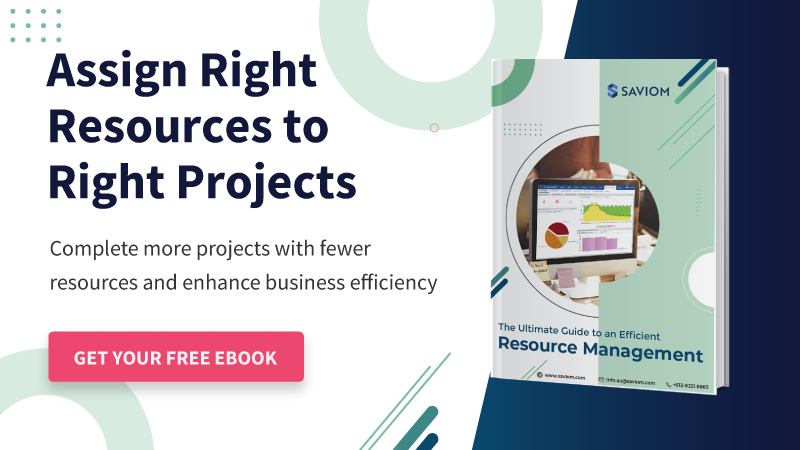In the last decade, resource or workforce planning and management have become a very critical component of modern businesses. This area has evolved and matured quite a bit. An array of novel concepts has been introduced ever since it started evolving.
This article attempts to provide a complete glossary of terms used for the resource or workforce planning, scheduling, and management. Links to different materials and videos have been provided to understand it better and dive deeper into the concepts.
Following topics categorize these terms.
Resource or Workforce Scheduling, Planning, and Management
Resource Capacity Planning and Workforce Optimization
Resource or Workforce Utilization and Productivity
Resource or Workforce Financials
Resource or Workforce Scheduling, Planning and Management Resource Management
Resource management
Resource management is the process of utilizing various types of business resources effectively and efficiently. These resources can be human resources, assets, facilities, equipment, etc.
Enterprise Resource Management (ERM)
Enterprise Resource management is utilizing various types of business resources effectively and efficiently across the whole enterprise. These resources can be human resources, assets, facilities, equipment, etc.
Resource Planning
Resource planning is process of planning, forecasting, allocating, and utilizing various types of business resources effectively and efficiently. These resources can be human resources, assets, facilities, equipment, etc.
Agile Resource Planning refers to where the resource planning is fast-changing in a dynamic environment.
Workforce Planning
Workforce planning is the process of planning, forecasting, allocating and utilizing workforce effectively and efficiently across the enterprise.
Resource Scheduling
Resource scheduling is the most crucial part of the resource planning process. It involves identifying and allocating resources for a specific period to various types of activities. It is
related to project work or non-project work i.e., like BAU, Support, admin, operation, etc.
Workforce Scheduling
Workforce scheduling is the most critical part of the workforce planning process. It involves identifying and allocating employees for a specific period to various types of activities. It is related to project work or non-project work i.e. like BAU, Support, admin, operation, etc.
Read More: What is Resource Scheduling? How to Schedule Resources for Projects Efficiently?
Resource Allocation
Resource allocation is an alternate word for resource scheduling. It involves identifying and allocating resources for a specific period to various types of activities. It is related to project work or non-project work i.e., like BAU, Support, admin, operation, etc.
Resource Forecasting
Resource forecasting is the process of predicting various resource metrics. It includes demand, supply, vacancies, on the bench, and resourcing cost in advance. This forecast helps a business to be proactive and take corrective action ahead of time.
Read More: Resource Forecasting Guide for Project Managers
FTE – Full-Time Equivalent
Full-time equivalent (FTE) is a unit of time defined to measure the workload or availability or capacity of an employee. One FTE is equivalent to the number of work hours for a full-time
employee in a week.
Example
For example, a company has full-time working hours of 8 hours a day and five days a week. For a full-time employee, this would be one FTE, which is 40 hours a week. For a part-time employee working half the time, this would be .5 FTE or 20 hours a week.
For better understanding, let us have a look at another example:
A company has full-time working hours of 7 hours in a day and 6 days a week. For a full-time employee, this would be one FTE, which is 42 hours a week. For a part-time employee working half the time, this would be .5 FTE, which is 21 hours a week.
Read More: Understanding Resource Availability within Project Management
Matrix Organizational Structure
A matrix organizational structure is where an employee has multiple reporting lines. In a matrix
organization, working teams have a horizontal working structure. However, the resources belong to different verticals i.e., departments, locations, functional areas, domains, business units.
In a project-based matrix structure, an individual works for multiple projects and reports to multiple project managers on an everyday basis. This individual, however, reports to a department head or domain head for performance evaluation, career progression, vacations, and other necessary aspects.
Now that we know what exactly resource management and planning is, let’s understand a few other concepts around the same.
Resource Capacity Planning and Workforce Optimization
Resource capacity is the total number of hours an individual is available to work as per the arrangement with the employer.
Example
For example, a company has full-time working hours of 8 hours in a day and five days a week.
For a full time, employee, the capacity would be 40 hours per a week or one FTE or five full person-days.
However, for a part-time employee working four days/week and 6 hours/day, the capacity would be 24 hours/week. It is equivalent to 0.6 FTE or Three full person-days.
Example
For example, a company has full-time working hours of 8 hours in a day and 5 days a week.
For a full time, employee, the capacity would be 40 hours per week or one FTE or 5 full person days.
On the other hand, for a part time employee working 4 days a week and 6 hours every day, the capacity would be 24 hours a week or .6 FTE or 3 full person days.
Read More: How to Measure Resource Capacity and Demand
Resource Demand
Resource demand is the process of understanding the number of resources required to meet the demand for various work types. Work can be related to projects, BAU, admin, support, etc. The amount of work can be measured in terms of hours, FTE, person, days, etc.
Example
A company has full-time working hours of 8 hours/day and 5 days/week, which is 40 hours/week.
If an employee is allocated 45 hours a week, then the demand for this employee is 45 hours/week. It is equivalent to 1.125 FTE or 5.625 person days/week.
Resource Capacity Vs. Demand
Capacity vs. demand is forecasting shortages or excesses of resources in the short or long term. It is achieved by analyzing the gaps between the capacity of resources against the demand for
resources. This gap can be measured in hours or FTE or Person days.
It is a shortage of resources when the demand is higher than the capacity or supply of resources. Conversely, it is an excess of resources when the demand is lower than
the capacity or supply of resources.
Resource Capacity Planning
Resource capacity planning is the process of forecasting the gap between capacity and demand. Efficient resource capacity planning bridges this gap.
The following are the benefits of Resource Capacity Planning:
- Match resources demand with the capacity
Capacity planning ensures the availability of the right resources for the right projects at the right time. It helps in the timely delivery of the projects within the budget. - Ensures that excess capacity is not wasted
Excessive future resource capacity can be identified by comparing future resource capacity vs. changing demand. This excessive capacity can be sold or utilized without wasting it. - Be proactive to match shortfall of resources
Shortage of future resource capacity can be identified by comparing future resource capacity vs. changing demand. The shortage of capacity can be mitigated by retraining/re-skilling people /juggling project priority or hiring people ahead of time.
Read More: What is Resource Capacity Planning? An Ultimate Guide for Every Project Manager
Resource Optimization
Resource optimization is an ongoing process of matching resource supply with changing resource demand to achieve efficient utilization of resources. These resources can be human resources, assets, facilities, equipment, etc.
Workforce Optimization
Workforce optimization is an ongoing process of matching workforce supply with changing workforce demand to achieve efficient utilization for the workforce.
On-Demand Workforce or Contingent Workforce
On-demand or contingent workforce consist of employees who can be hired and when extra demand for work arises in the business. Generally, casuals, contractors, and freelancers are part of the on-demand workforce. These resources can be hired to meet the fluctuating workload of the business.
Businesses facing volatility of workload due to changing market conditions require on-demand or contingent workforce. It saves them from the ongoing overhead of maintaining permanent staff without utilizing them effectively throughout the employment period.
Read More: Getting Resource Leveling Right for Projects
Modern businesses are maintaining the right mix of permanent/on-demand staff to minimize resourcing costs and being responsive to volatile workload.
For Example, an accounting and auditing company would require an on-demand workforce to meet seasonal fluctuations of workload during the tax period.
People on the Bench
People on the bench refers to the employees who are currently sitting idle. They are expected to work to be assigned to them in the future.
For example,There’s a pool of 10 resources, and two civil engineers will be idle from Monday until Friday. It means these two employees are on the bench, and they need to be allocated with work.
Since we now know how to plan and allocate the capacity effectively, let us gauge their utilization and productivity.
Read More: How to Measure Different Types of Resource Utilization
Resource or Workforce Utilization and Productivity
Resource Utilization & Optimal Utilization
Resource utilization is the way to measure how effectively resources are utilized against their availability or capacity.
Resource utilization = Actual or allocated work time / Available resource time or resource capacity
It can be measured in percentages or hours or days or FTE.
Optimal utilization of the resource is the process of maximising utilization of resources to achieve most out of your available resources.
Read More: Maximize Profitable Resource Utilization with Modern Resource Management Solution
Example
An employee’s capacity is 40 hours/week, and the total work allocated to this employee is 48 hours. Then the utilization of this resource is 120% (48/40) or 1.2 FTEs, which is over-utilization of the resource.
Similarly, if the work allocated to this employee is 36 hours. Then, this resource utilization is 90% (36/40) or .9 FTE, which is under-utilization of this resource.
Billable Project
Billable project refers to the project where time spent on the work by a resource will be billed to a client.
For example, a project for “Implementing SAVIOM for PMEntire” is a billable project. Here the time spent on this project by a consultant from SAVIOM would be billed to PMEntire.
Read More: What is Resource Planning, and Why is it Important in Project Management?
Strategic Project
Strategic project refers to the project which is meant to meet the long-term strategic goal of the organization.
For example, a project for “Diversifying into a new product line” is a strategic project. It’s long-term strategic goal is to “Increasing Company Revenue by 500% in 3 Years”.
Billable Time, Non-Billable Time & Strategic Time
Billable time is the time spent by a resource on an activity which will be billed to a client.
Non-Billable time is the time spent by a resource on an activity which can’t be billed to a client. This time is generally related to BAU, admin, internal meetings, bidding work, etc.
Strategic time is the time spent by a resource on an activity which is related to a strategic project.
Billable or Non-Billable or Strategic Utilization
Billable utilization is the way to measure how much a resource is utilized for billable work against its availability or capacity.
Billable Resource utilization = Actual or allocated billable time / Available resource time or resource capacity
Similarly,
Non-Billable Resource utilization = Actual or allocated non-billable time / Available resource time or resource capacity
Strategic Resource utilization = Actual or allocated strategic time / Available resource time or resource capacity
Example
The capacity of an employee is 40 hours/week and total work allocated to this employee is 44 hours.
44 Hours of work has been allocated in following ways:
- 16 hours are allocated to billable work
- 20 hours are allocated to non-billable work
- 8 hours are allocated to strategic work
Overall Resource utilization = 44 hours / 40 hours = 110%
Billable Resource utilization = 16 hours / 40 hours = 40%
Non-Billable Resource utilization = 20 hours / 40 hours = 50%
Strategic Resource utilization = 8 hours / 40 hours = 20%
Read More: 5 Top Project Metrics You Need to Use Today
Utilization Heatmap and Over/ Under Utilization
Utilization heatmap is a colour-coded representation of utilization of resources, teams, departments, skills, and other attributes. Heatmap provides fast and comprehensive analysis of under or overutilization. Colors in the heatmap are used to depict different levels of utilization or availability.
Example
For example, the following colors can be used as per the policy of a company to measure different levels of utilization:
- Utilization below 80% represented by red color depicting under utilization
- Utilization between 81- 90% represented by yellow color depicting average utilization
- Utilization between 91-110% represented by green color depicting optimal utilization
- Utilization above 110% represented by orange color depicting over-utilization
Let us now dive into the technicalities of resource financials:
Resource or Workforce Financials
Cost Rate
Cost rates are individual costs of an employee or contractor to you as a business.
Cost of an employee includes Salary + Other overheads (Office space, Office infrastructure, and other exp.)
For example,
A person X who is a developer and the organization is spending:
- 35k per month on his Salary
- 10k per month for his office desk and computer
- 05k other expenses such as tea, meeting room exp., snacks, etc
So, the cost rate in this scenario For X would be
35 + 10 + 5 = 50k per month.
That calculates approximately around $300/Hr for the organization.
Charge out Rate
Charge out rate for an employee is what you charge to the customer for a specific service.
Charge out rate includes Resource cost with some added margin to the organization.
For example,
Person X who is a full-time working for 8hrs./day and his charge-out rate is $500/hr.
Let’s say he’s putting:
- 6hrs. on Billable work
- 2hrs. on Non-Billable work
the amount charged for X would be $500 x 6 = $3000.
Read More: Reduce Resourcing Cost by 10-30% with Modern Resource Management Solution
ROI – Return on Investment
Return on investment (ROI) measures the gain or loss generated on an investment relative to the amount of money invested.
Formulae to calculate ROI:
ROI = (Gain or Loss / Cost of Investment) x 100
For example,
An investor buys $1,000 worth of stocks and sells the shares two years later for $1,200. The net profit from the investment would be $200, and the ROI would be calculated as follows:
ROI = (200 / 1,000) x 100 = 20%
The ROI in the example, as mentioned above, would be 20%. The calculation can be altered by deducting taxes and fees to get a more an accurate picture of the total ROI.
These are the essential concepts one must know while managing resources. I hope this glossary proves insightful to make data-driven decisions and to manage the resource pool efficiently.
Saviom Solution
SAVIOM has over 20 years of experience helping multinational clients manage their resources efficiently and effectively. With over 20 years of experience, this Australian-based MNC has a global presence across 50 countries and has helped 100+ clients meet their specific business goals. Saviom also provides tools for project portfolio management, professional service automation, and workforce planning software. So, SAVIOM can help your business to establish an efficient system geared towards your specific business challenges.












